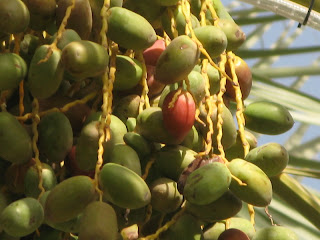Do you know these facts ? (photo taken in Al ain Rotana )
Date Palm Culture exists in the UAE since several thousand years ago as apart of the Gulf ecosystem, from which date palm was propagated around the world.
Date Palm in UAE is grown in three main regions: both Western & Eastern Coastal Areas, Inland areas (from Ras Al Khaima to Al Ain); and various Oasis (mostly Liwa & Al Ain ).
Date Palm plays an important socio-economical role in the UAE. Before Oil discovery, date palm was used for all purposes.
Thanks to the wise instructions and great concern of His Highness Sheikh Zayed Bin Sultan Al Nahayan, the UAE President, the UAE annual date production has jumped from less than 8,000 metric tonnes (MT) in 1971 to more than 140,000 MT in 1995 (30 times) and to 500,000 MT in 2000.
Do YouThe Actual date tree population is about 40 million of which 33 million palms are in Abu Dhabi Emirate alone, also of which 8.5 millions are in Al Ain orchards (UAE News Agency – Al Khaleej No. 7763 of 20/08/200.
The UAE date harvest area has jumped from less than 60 ha in 1971to 31,005 ha in 1996 (48 times).
During the first week of August of each year, there is an annual Date Festival organized at Liwa, where date growers present their various products.
The earliest known record of date palm cultivation is in Iraq (Mesopotamia) as early as 3000 B.C.
Date Palm is irreplaceable in irrigable desert lands.
Date Palm trees supply an average of two thirds of income of people living in the Sahara.
Date Palm provides protection to under-crops from the harshness of the climate (heat, wind and even cold weather); it allows the cultivation of some fruit trees and annual crops.
Date plantations provide work to a considerable number of peasants.
The date palm belongs to the family Palmae, genus Phoenix, species dactylifera.
The date palm can be distinguished from the Canary Island Palm(Phoenix canariensis) by a narrower trunk, the presence of offshoots, and more widely spaced leaves.
Date palms are dioecious: female flowers produce the fruit andmale flowers produce the pollen. Two good male palms will usually produce enough pollen to pollinate about fifty female palms.
Dates may be propagated from seeds or from offshoots. When grown from seeds, about half will be males and varieties will be unknown. When grown from offshoots, the trees will be identical to its parent.
Date palms produce offshoots during the first four or five yearsafter planting. Once the offshoots have been removed, no further offshoot production occurs.
The cutting of a date offshoot from the parent palm is an operation requiring care and skill.
For proper maturing of fruit, the date requires prolonged summerheat and low humidity during the ripening period.
Date palms are picked several times during the harvest seasonsince dates don’t all ripen simultaneously.
Date varieties can be grouped into three types: soft, semi-dry and dry (or bread) dates.
Soft type dates have a soft flesh, a high moisture content and a relatively low sugar content.
Semi-dry varieties have a firm flesh, fairly low moisture contentand a high sugar content.
Dry (or bread) dates have a high sugar content, a very low moisture content, and a dry, hard flesh.
The average annual per capita consumption of dates in manyCountries is very high: 150 - 185 Kgs.
Date fruits offer a good source of high nutritive value:
* Apricot: 520 calories/kg
* Banana: 970 calories/kg
* Orange: 480 calories/kg
* Dates: 3000 calories/kg
Date fruits possess a profile of an attractive product with:
* Pleasant taste.
* Natural and healthy.
* Laxative/Digestive effect because of its fibers.
* A very complete food.
* A high energy level.
http://datepalm.uaeu.ac.ae/subpages/doYouKnowfacts.html










No comments:
Post a Comment